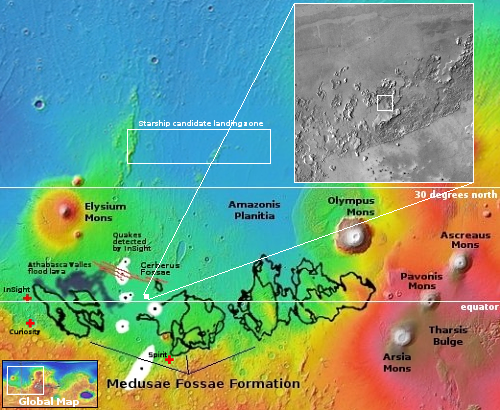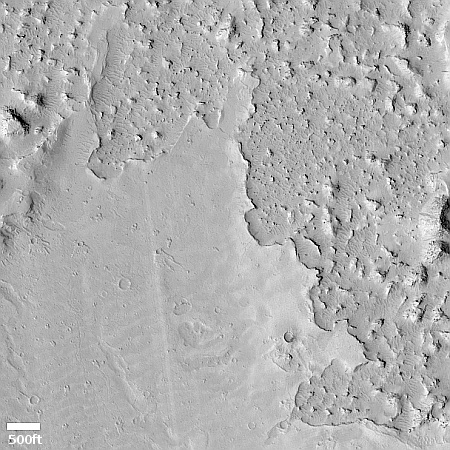Peeling flood lava on Mars
Cool image time! The picture to the right, cropped, reduced, and sharpened to post here, was taken on October 2, 2024 by the high resolution camera on Mars Reconnaissance Orbiter (MRO).
The scientists label this “enigmatic terrain” because its origins are a bit difficult to decipher. The location is just north of the equator, so this is in the dry tropics of Mars, where no near-surface ice is found at all. The location is also in the middle of Elysium Planitia, one of the largest flood lava plains on Mars. Elysium is a largely featureless flat plain, where flood lava from the large giant Martian volcanoes covered a vast region.
Here however that top layer of flood lava appears almost like peeling paint that failed to stick to the underlying rougher terrain. In many places it is gone, exposing a stippled surface that is also likely flood lava but laid down either in a rougher manner or eroded over time to leave a rougher surface.

The white dot on the overview map to the right marks the location, deep inside the smoothest region of Elysium Planitia. The inset however shows that this particular location is hardly smooth. While the flood lava to the north and south is almost polished smooth, this location is in a strip of ground where that top layer of lava has eroded away. Once again, it appears as if that top layer didn’t stick very well, and wind and time allowed it to peel away to expose the older rougher layers below.
The geological mystery is why that top layer didn’t stick and eroded away. Was there a difference in make-up between the two layers that made them easily separated? And why only here?
One answer might be the simplest. That top layer might not have eroded away. Instead, this rough area might be slightly higher in elevation, and the flood lava simply didn’t cover it all. Sounds good, eh? The problem is that the elevation data doesn’t match. The downhill grade is from north to south, and crosses this rough terrain. It simply isn’t higher.
On Christmas Eve 1968 three Americans became the first humans to visit another world. What they did to celebrate was unexpected and profound, and will be remembered throughout all human history. Genesis: the Story of Apollo 8, Robert Zimmerman's classic history of humanity's first journey to another world, tells that story, and it is now available as both an ebook and an audiobook, both with a foreword by Valerie Anders and a new introduction by Robert Zimmerman.
The print edition can be purchased at Amazon or from any other book seller. If you want an autographed copy the price is $60 for the hardback and $45 for the paperback, plus $8 shipping for each. Go here for purchasing details. The ebook is available everywhere for $5.99 (before discount) at amazon, or direct from my ebook publisher, ebookit. If you buy it from ebookit you don't support the big tech companies and the author gets a bigger cut much sooner.
The audiobook is also available at all these vendors, and is also free with a 30-day trial membership to Audible.
"Not simply about one mission, [Genesis] is also the history of America's quest for the moon... Zimmerman has done a masterful job of tying disparate events together into a solid account of one of America's greatest human triumphs."--San Antonio Express-News
Cool image time! The picture to the right, cropped, reduced, and sharpened to post here, was taken on October 2, 2024 by the high resolution camera on Mars Reconnaissance Orbiter (MRO).
The scientists label this “enigmatic terrain” because its origins are a bit difficult to decipher. The location is just north of the equator, so this is in the dry tropics of Mars, where no near-surface ice is found at all. The location is also in the middle of Elysium Planitia, one of the largest flood lava plains on Mars. Elysium is a largely featureless flat plain, where flood lava from the large giant Martian volcanoes covered a vast region.
Here however that top layer of flood lava appears almost like peeling paint that failed to stick to the underlying rougher terrain. In many places it is gone, exposing a stippled surface that is also likely flood lava but laid down either in a rougher manner or eroded over time to leave a rougher surface.

The white dot on the overview map to the right marks the location, deep inside the smoothest region of Elysium Planitia. The inset however shows that this particular location is hardly smooth. While the flood lava to the north and south is almost polished smooth, this location is in a strip of ground where that top layer of lava has eroded away. Once again, it appears as if that top layer didn’t stick very well, and wind and time allowed it to peel away to expose the older rougher layers below.
The geological mystery is why that top layer didn’t stick and eroded away. Was there a difference in make-up between the two layers that made them easily separated? And why only here?
One answer might be the simplest. That top layer might not have eroded away. Instead, this rough area might be slightly higher in elevation, and the flood lava simply didn’t cover it all. Sounds good, eh? The problem is that the elevation data doesn’t match. The downhill grade is from north to south, and crosses this rough terrain. It simply isn’t higher.
On Christmas Eve 1968 three Americans became the first humans to visit another world. What they did to celebrate was unexpected and profound, and will be remembered throughout all human history. Genesis: the Story of Apollo 8, Robert Zimmerman's classic history of humanity's first journey to another world, tells that story, and it is now available as both an ebook and an audiobook, both with a foreword by Valerie Anders and a new introduction by Robert Zimmerman.
The print edition can be purchased at Amazon or from any other book seller. If you want an autographed copy the price is $60 for the hardback and $45 for the paperback, plus $8 shipping for each. Go here for purchasing details. The ebook is available everywhere for $5.99 (before discount) at amazon, or direct from my ebook publisher, ebookit. If you buy it from ebookit you don't support the big tech companies and the author gets a bigger cut much sooner.
The audiobook is also available at all these vendors, and is also free with a 30-day trial membership to Audible.
"Not simply about one mission, [Genesis] is also the history of America's quest for the moon... Zimmerman has done a masterful job of tying disparate events together into a solid account of one of America's greatest human triumphs."--San Antonio Express-News



“The location is just north of the equator, so this is in the dry tropics of Mars, where no near-surface ice is found at all.”
Well, Mars equator, hasn’t always been Mars equator- in geological time, Mars equator hasn’t been dry tropics, but lots of time as wet polar region.
gbaikie: You are absolutely right. However, the geology visible now is all lava-based, from those volcanic eruptions. While it is certainly possible near-surface ice in the past helped erode that lava, in this case I have doubts.